MITSUBISHI SHOGUN 2008 Owner's Manual (in English)
Manufacturer: MITSUBISHI, Model Year: 2008, Model line: SHOGUN, Model: MITSUBISHI SHOGUN 2008Pages: 538, PDF Size: 25.09 MB
Page 251 of 538
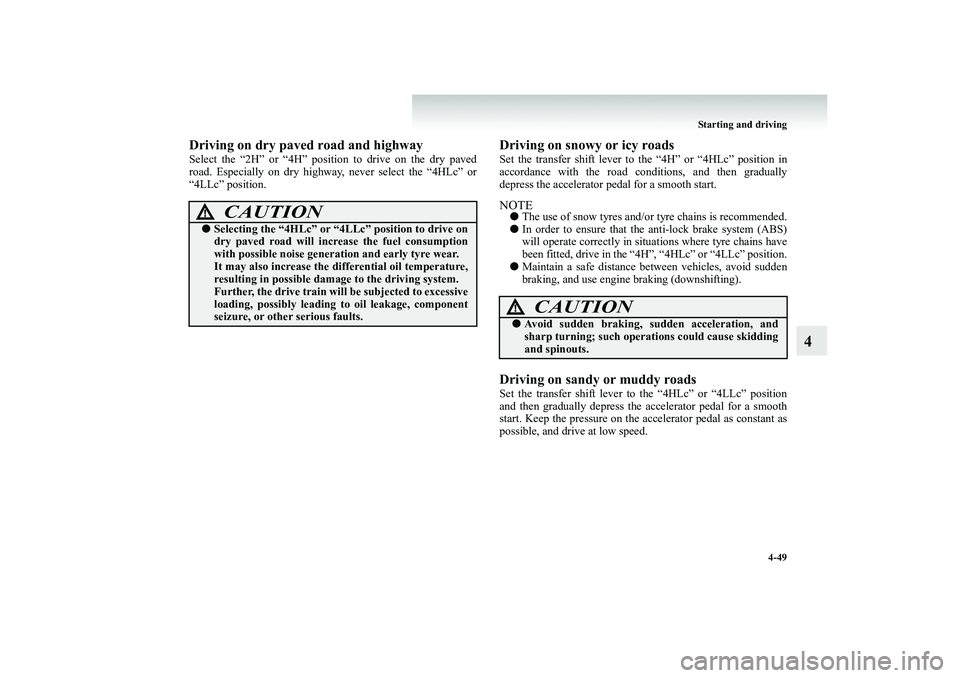
Starting and driving
4-49
4
Driving on dry paved road and highwaySelect the “2H” or “4H” position to drive on the dry paved road. Especially on dry highway
, never select the “4HLc” or
“4LLc” position.
Driving on snowy or icy roads Set the transfer shift lever to
the “4H” or “4HLc” position in
accordance with the road conditions, and then graduallydepress the accelerator pe
dal for a smooth start.
NOTE●
The use of snow tyres and/or tyre chains is recommended.
●
In order to ensure that the
anti-lock brake
system (ABS)
will operate correctly in situ
ations where tyre chains have
been fitted, drive in the “4
H”, “4HLc” or “4LLc” position.
●
Maintain a safe distance between vehicles, avoid sudden braking, and use engine braking (downshifting).
Driving on sandy or muddy roadsSet the transfer shift lever to the “4HLc” or “4LLc” positionand then gradually depress th
e accelerator pedal for a smooth
start. Keep the pressure on th
e accelerator pedal as constant as
possible, and drive at low speed.
CAUTION
!●
Selecting the “4HLc” or “4LLc” position to drive on dry paved road will increase the fuel consumption with possible noise genera
tion and early tyre wear.
It may also increase the di
fferential oil temperature,
resulting in possible damage to the driving system. Further, the drive train wi
ll be subjected to excessive
loading, possibly leading
to oil leakage, component
seizure, or other serious faults.
CAUTION
!●
Avoid sudden braking, sudden acceleration, and sharp turning; such opera
tions could cause skidding
and spinouts.
BK-BK2008E1ENUK.en-uk-Section7.fm Page
49 Wednesday, January 9, 2008 4:36 PM
Page 252 of 538
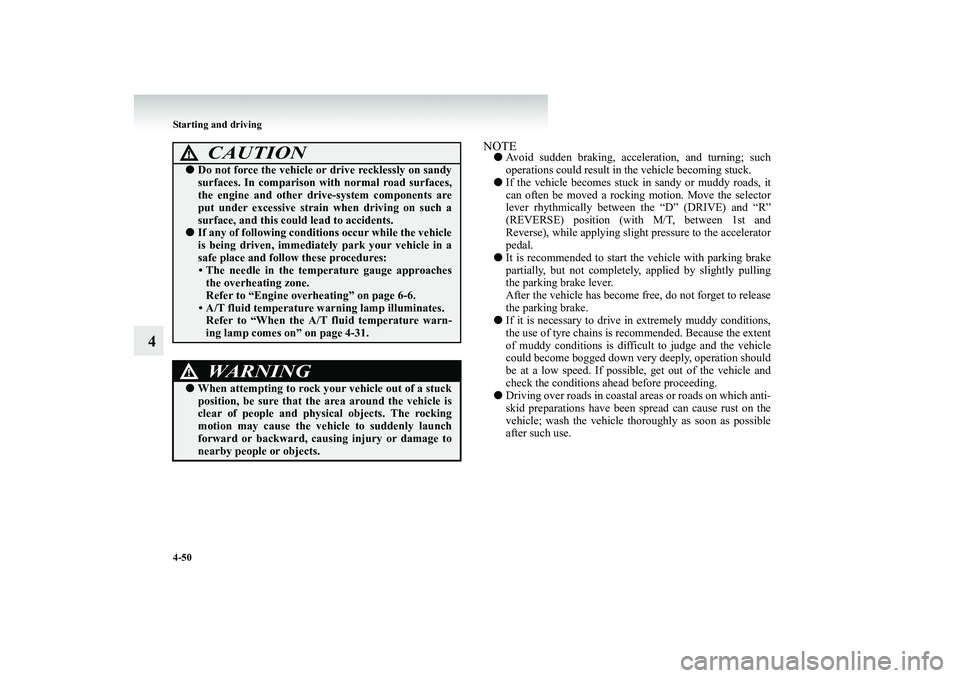
4-50 Starting and driving
4
NOTE●
Avoid sudden braking, acceler
ation, and turning; such
operations could result in the vehicle becoming stuck.
●
If the vehicle becomes stuck in sandy or muddy roads, it can often be moved a rocking motion. Move the selectorlever rhythmically between
the “D” (DRIVE) and “R”
(REVERSE) position (with M/T, between 1st and Reverse), while applying sli
ght pressure to the accelerator
pedal.
●
It is recommended to start th
e vehicle with parking brake
partially, but not completely, applied by slightly pullingthe parking brake lever. After the vehicle has become fr
ee, do not forget to release
the parking brake.
●
If it is necessary to drive in extremely muddy conditions, the use of tyre chains is recommended. Because the extent of muddy conditions is difficult to judge and the vehiclecould become bogged down very deeply, operation should be at a low speed. If possible
, get out of the vehicle and
check the conditions ah
ead before proceeding.
●
Driving over roads in coastal
areas or roads on which anti-
skid preparations have been
spread can cause rust on the
vehicle; wash the vehicle thoroughly as soon as possibleafter such use.
CAUTION
!●
Do not force the vehicle or drive recklessly on sandy surfaces. In comparison wi
th normal road surfaces,
the engine and other driv
e-system components are
put under excessive strain
when driving on such a
surface, and this coul
d lead to accidents.
●
If any of following conditions occur while the vehicle is being driven, immediatel
y park your vehicle in a
safe place and follow these procedures:• The needle in the temp
erature gauge approaches
the overheating zone. Refer to “Engine overheating” on page 6-6. • A/T fluid temperature warning lamp illuminates. Refer to “When the A/T fluid temperature warn-ing lamp comes on” on page 4-31.WARNING
!●
When attempting to rock your vehicle out of a stuck position, be sure that the area around the vehicle is clear of people and physic
al objects. The rocking
motion may cause the vehicle to suddenly launch forward or backward, caus
ing injury or damage to
nearby people or objects.
BK-BK2008E1ENUK.en-uk-Section7.fm Page
50 Wednesday, January 9, 2008 4:36 PM
Page 253 of 538
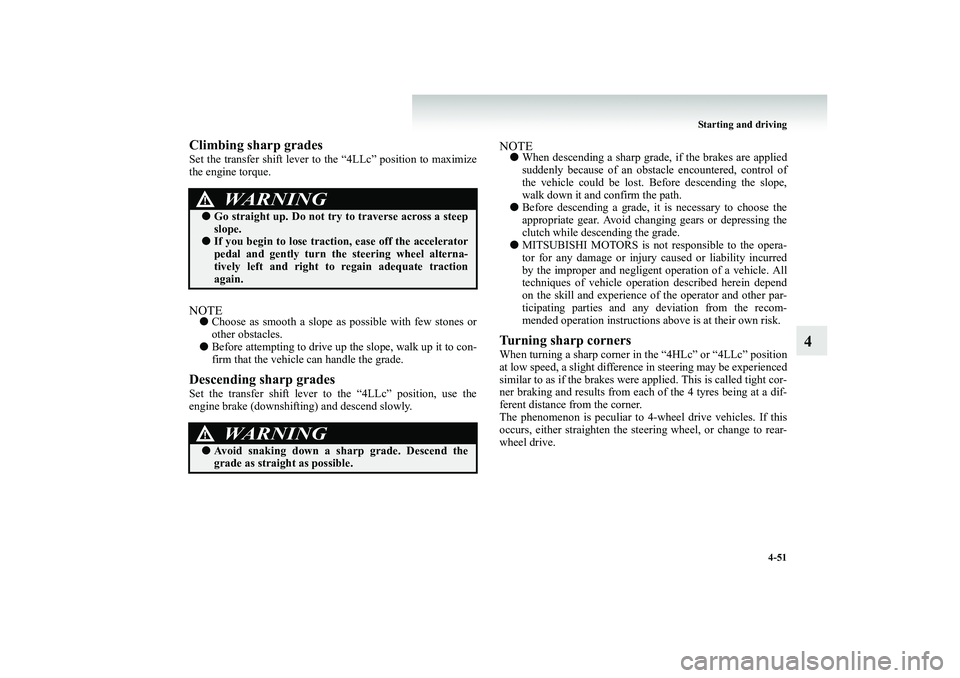
Starting and driving
4-51
4
Climbing sharp gradesSet the transfer shift lever to
the “4LLc” position to maximize
the engine torque.NOTE●
Choose as smooth a slope as possible with few stones or other obstacles.
●
Before attempting to drive up the slope, walk up it to con- firm that the vehicle can handle the grade.
Descending sharp gradesSet the transfer shift lever to the “4LLc” position, use the engine brake (downshifting) and descend slowly.
NOTE●
When descending a sharp grade,
if the brakes are applied
suddenly because of an obstacle encountered, control of the vehicle could be lost. Before descending the slope, walk down it and confirm the path.
●
Before descending a grade, it is necessary to choose the appropriate gear. Avoid changi
ng gears or depressing the
clutch while descending the grade.
●
MITSUBISHI MOTORS is not responsible to the opera- tor for any damage or injury caused or liability incurred by the improper and negligent operation of a vehicle. Alltechniques of vehicle operation described herein depend on the skill and experience of the operator and other par- ticipating parties and any deviation from the recom-mended operation instructions above is at their own risk.
Turning sharp cornersWhen turning a sharp corner in
the “4HLc” or “4LLc” position
at low speed, a slight differen
ce in steering may be experienced
similar to as if the brakes were applied. This is called tight cor-ner braking and results from each of the 4 tyres being at a dif- ferent distance fr
om the corner.
The phenomenon is peculiar to 4-wheel drive vehicles. If thisoccurs, either straighten the st
eering wheel, or change to rear-
wheel drive.
WARNING
!●
Go straight up. Do not try to traverse across a steep slope.
●
If you begin to lose traction, ease off the accelerator pedal and gently turn th
e steering wheel alterna-
tively left and right to regain adequate tractionagain.WARNING
!●
Avoid snaking down a sharp grade. Descend the grade as straight as possible.
BK-BK2008E1ENUK.en-uk-Section7.fm Page
51 Wednesday, January 9, 2008 4:36 PM
Page 254 of 538
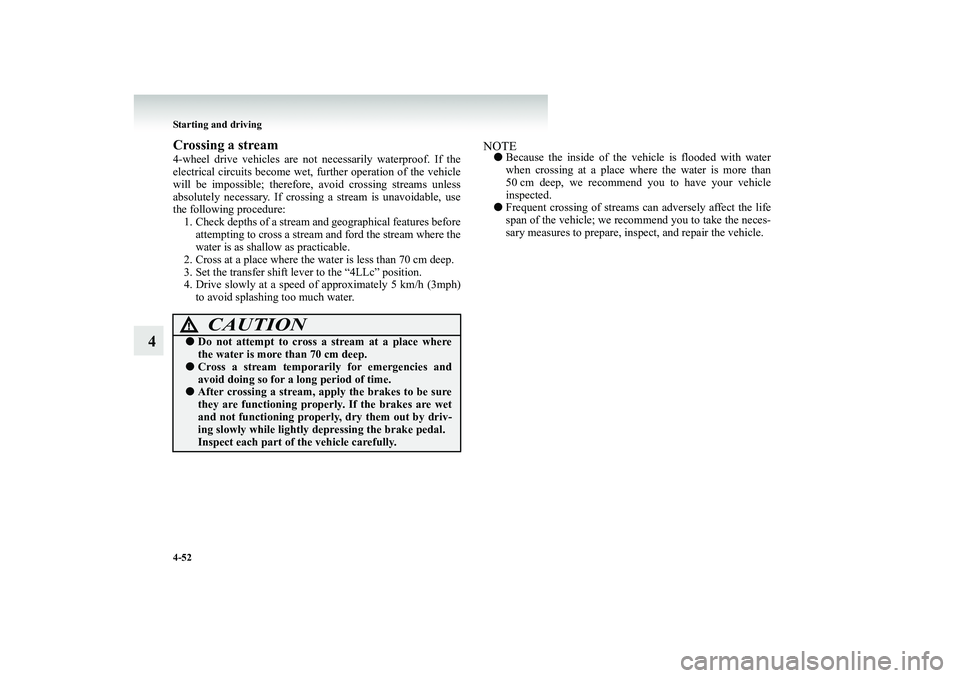
4-52 Starting and driving
4
Crossing a stream4-wheel drive vehicles are not
necessarily waterproof. If the
electrical circuits become wet,
further operation
of the vehicle
will be impossible; therefore,
avoid crossing streams unless
absolutely necessary. If crossi
ng a stream is unavoidable, use
the following procedure:1. Check depths of a stream a
nd geographical features before
attempting to cross a stream
and ford the stream where the
water is as shallow as practicable.
2. Cross at a place where the water is less than 70 cm deep. 3. Set the transfer shift lever to the “4LLc” position. 4. Drive slowly at a speed of
approximately 5 km/h (3mph)
to avoid splashing too much water.
NOTE●
Because the inside of the ve
hicle is flooded with water
when crossing at a place wh
ere the water is more than
50 cm deep, we recommend you to have your vehicle inspected.
●
Frequent crossing of streams
can adversely affect the life
span of the vehicle; we recommend you to take the neces- sary measures to prepare, in
spect, and repair the vehicle.
CAUTION
!●
Do not attempt to cross a stream at a place where the water is more than 70 cm deep.
●
Cross a stream temporar
ily for emergencies and
avoid doing so for a long period of time.
●
After crossing a stream, apply the brakes to be sure they are functioning properl
y. If the brakes are wet
and not functioning properly, dry them out by driv-ing slowly while lightly de
pressing the brake pedal.
Inspect each part of
the vehicle carefully.
BK-BK2008E1ENUK.en-uk-Section7.fm Page
52 Wednesday, January 9, 2008 4:36 PM
Page 255 of 538
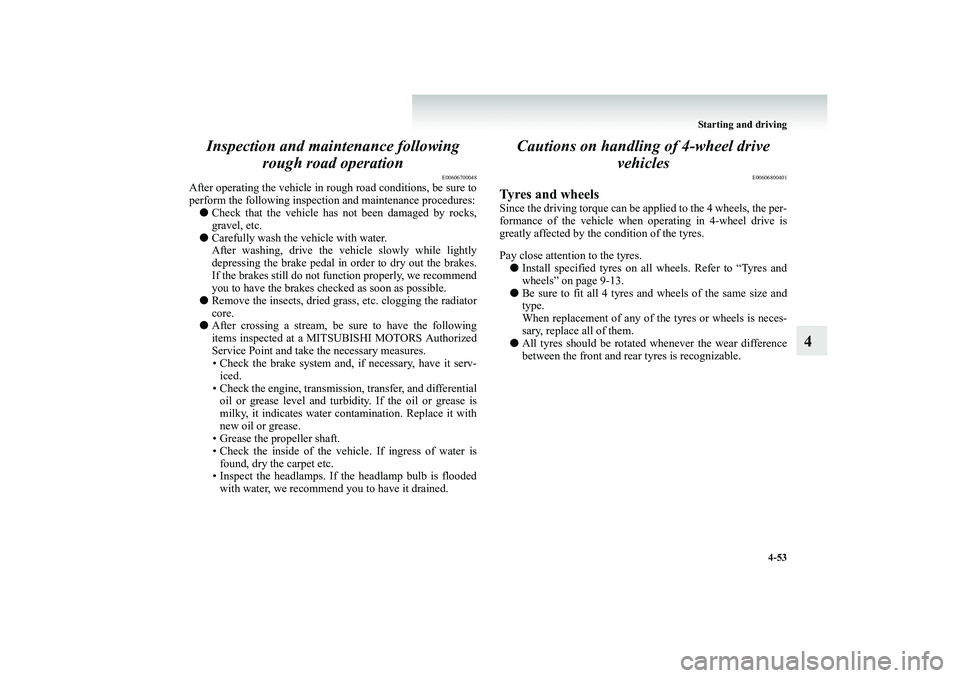
Starting and driving
4-53
4
Inspection and main
tenance following
rough road operation
E00606700048
After operating the vehicle in rough road conditions, be sure to perform the following inspection and maintenance procedures: ●
Check that the vehicle has not been damaged by rocks, gravel, etc.
●
Carefully wash the vehicle with water. After washing, drive the vehicle slowly while lightlydepressing the brake pedal in order to dry out the brakes. If the brakes still do not function properly, we recommend you to have the brakes checked as soon as possible.
●
Remove the insects, dried grass, etc. clogging the radiator core.
●
After crossing a stream, be sure to have the following items inspected at a MITS
UBISHI MOTORS Authorized
Service Point and take the necessary measures. • Check the brake system and,
if necessary, have it serv-
iced. • Check the engine, transmissi
on, transfer, and differential
oil or grease level and turbid
ity. If the oil or grease is
milky, it indicates water co
ntamination. Replace it with
new oil or grease. • Grease the propeller shaft.• Check the inside of the vehi
cle. If ingress of water is
found, dry the carpet etc. • Inspect the headlamps. If th
e headlamp bulb is flooded
with water, we recommend you to have it drained.
Cautions on handling
of 4-wheel drive
vehicles
E00606800401
Tyres and wheelsSince the driving torque can be
applied to the 4 wheels, the per-
formance of the vehicle when
operating in 4-wheel drive is
greatly affected by th
e condition of the tyres.
Pay close attention to the tyres. ●
Install specified tyres on all
wheels. Refer to “Tyres and
wheels” on page 9-13.
●
Be sure to fit all 4 tyres an
d wheels of the same size and
type. When replacement of any of th
e tyres or wheels is neces-
sary, replace all of them.
●
All tyres should be rotated
whenever the wear difference
between the front and rear tyres is recognizable.
BK-BK2008E1ENUK.en-uk-Section7.fm Page
53 Wednesday, January 9, 2008 4:36 PM
Page 256 of 538
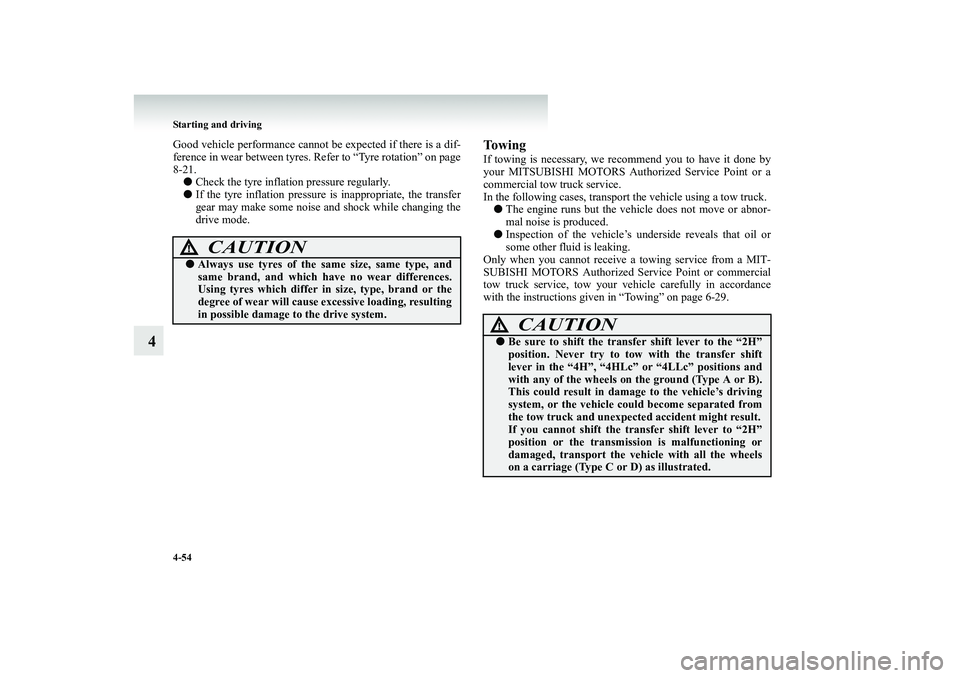
4-54 Starting and driving
4
Good vehicle performance cannot be expected if there is a dif- ference in wear between tyres. Refer to “Tyre rotation” on page 8-21. ●
Check the tyre inflation pressure regularly.
●
If the tyre inflation pressure
is inappropriate, the transfer
gear may make some noise and shock while changing the drive mode.
To w i n gIf towing is necessary, we recommend you to have it done byyour MITSUBISHI MOTORS Authorized Service Point or acommercial tow
truck service.
In the following cases, transpor
t the vehicle using a tow truck.
●
The engine runs but the vehicle does not move or abnor- mal noise is produced.
●
Inspection of the vehicle’s und
erside reveals that oil or
some other fluid is leaking.
Only when you cannot receive a towing service from a MIT- SUBISHI MOTORS Authorized
Service Point or commercial
tow truck service, tow your ve
hicle carefully in accordance
with the instructions given in “Towing” on page 6-29.
CAUTION
!●
Always use tyres of the same size, same type, and same brand, and which have no wear differences.Using tyres which differ in size, type, brand or the degree of wear will cause excessive loading, resulting in possible damage to the drive system.
CAUTION
!●
Be sure to shift the tran
sfer shift lever to the “2H”
position. Never try to tow with the transfer shift lever in the “4H”, “4HLc” or “4LLc” positions and with any of the wheels on
the ground (Type A or B).
This could result in damage to the vehicle’s driving system, or the vehicle could become separated from the tow truck and unexpected
accident might result.
If you cannot shift the tr
ansfer shift lever to “2H”
position or the transmission is malfunctioning or damaged, transport the ve
hicle with all the wheels
on a carriage (Type C or D) as illustrated.
BK-BK2008E1ENUK.en-uk-Section7.fm Page
54 Wednesday, January 9, 2008 4:36 PM
Page 257 of 538
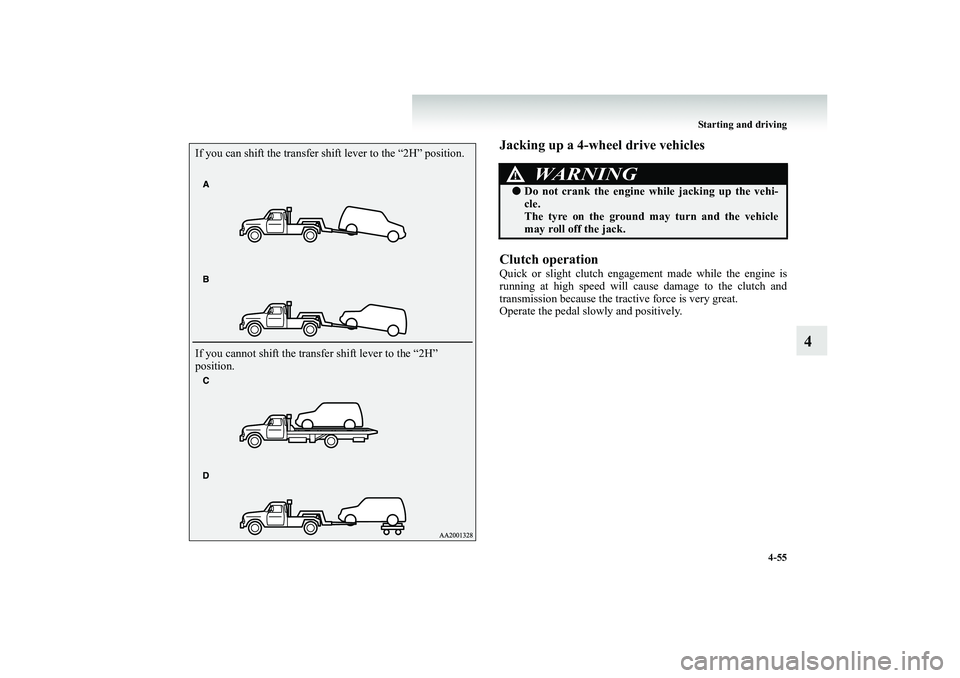
Starting and driving
4-55
4
Jacking up a 4-wheel drive vehicles Clutch operationQuick or slight clutch engagement made while the engine is running at high speed will cause damage to the clutch and transmission because the tractive force is very great. Operate the pedal slowly and positively.
If you can shift the transfer shift lever to the “2H” position. If you cannot shift the transf
er shift lever to the “2H”
position.
WARNING
!●
Do not crank the engine wh
ile jacking up the vehi-
cle. The tyre on the ground
may turn and the vehicle
may roll off the jack.
BK-BK2008E1ENUK.en-uk-Section7.fm Page
55 Wednesday, January 9, 2008 4:36 PM
Page 258 of 538
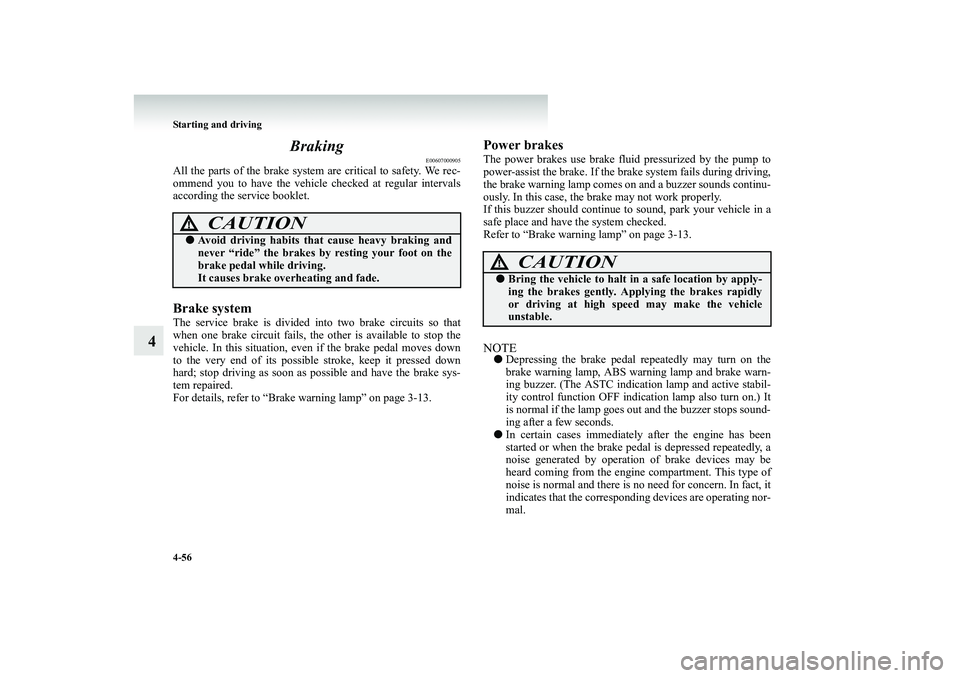
4-56 Starting and driving
4
Braking
E00607000905
All the parts of the brake system
are critical to safety. We rec-
ommend you to have the vehicle
checked at regular intervals
according the service booklet.Brake systemThe service brake is divided in
to two brake circuits so that
when one brake circuit fails, the
other is available to stop the
vehicle. In this situation, even if the brake pedal moves down to the very end of its possible stroke, keep it pressed down hard; stop driving as soon as possible and have the brake sys-tem repaired. For details, refer to “Brake warning lamp” on page 3-13.
Power brakesThe power brakes use brake fl
uid pressurized by the pump to
power-assist the brake.
If the brake system fails during driving,
the brake warning lamp comes
on and a buzzer sounds continu-
ously. In this case, the br
ake may not work properly.
If this buzzer should continue to
sound, park your vehicle in a
safe place and have the system checked. Refer to “Brake warning lamp” on page 3-13.NOTE●
Depressing the brake pedal re
peatedly may turn on the
brake warning lamp, ABS warning lamp and brake warn-ing buzzer. (The ASTC indicat
ion lamp and active stabil-
ity control function OFF indication lamp also turn on.) It is normal if the lamp goes out and the buzzer stops sound-ing after a few seconds.
●
In certain cases immediately after the engine has been started or when the brake peda
l is depressed repeatedly, a
noise generated by operation of brake devices may be heard coming from the engine compartment. This type of noise is normal and there is no
need for concern. In fact, it
indicates that the correspondi
ng devices are operating nor-
mal.
CAUTION
!●
Avoid driving habits that cause heavy braking and never “ride” the brakes by
resting your foot on the
brake pedal while driving. It causes brake overheating and fade.
CAUTION
!●
Bring the vehicle to halt in a safe location by apply- ing the brakes gently. Appl
ying the brakes rapidly
or driving at high speed may make the vehicleunstable.
BK-BK2008E1ENUK.en-uk-Section7.fm Page
56 Wednesday, January 9, 2008 4:36 PM
Page 259 of 538
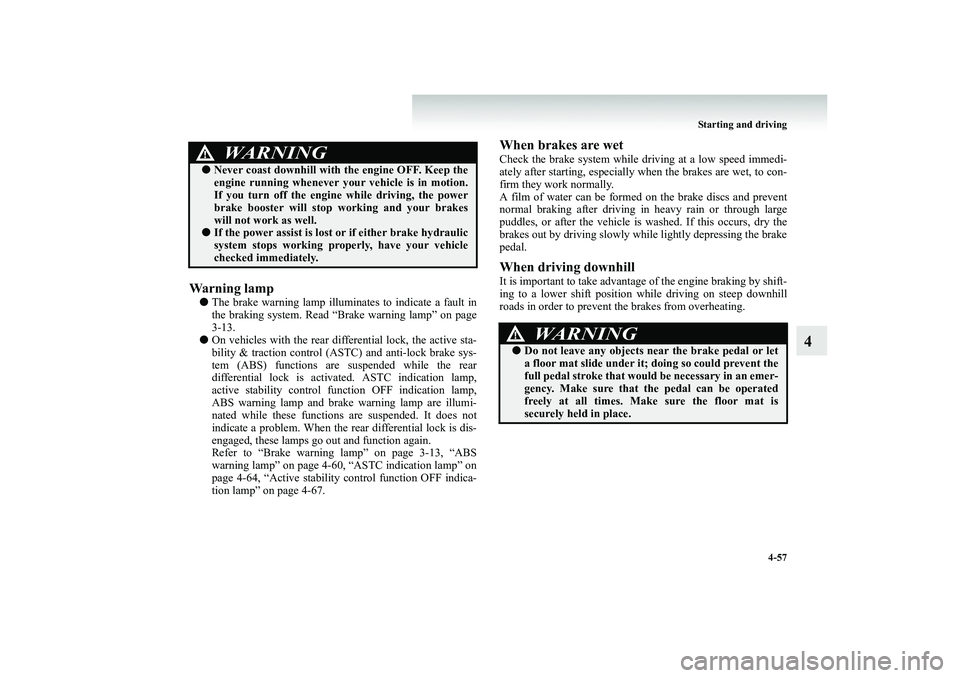
Starting and driving
4-57
4
Wa r n i n g l a m p●
The brake warning lamp illuminates to indicate a fault in the braking system. Read “Brake warning lamp” on page 3-13.
●
On vehicles with the rear di
fferential lock, the active sta-
bility & traction control (AST
C) and anti-lock brake sys-
tem (ABS) functions are
suspended while the rear
differential lock is activat
ed. ASTC indication lamp,
active stability control function OFF indication lamp, ABS warning lamp and brake warning lamp are illumi- nated while these functions are suspended. It does notindicate a problem. When the re
ar differential lock is dis-
engaged, these lamps go out and function again. Refer to “Brake warning lamp” on page 3-13, “ABSwarning lamp” on page 4-60, “ASTC indication lamp” on page 4-64, “Active stability control function OFF indica- tion lamp” on page 4-67.
When brakes are wetCheck the brake system while dr
iving at a low speed immedi-
ately after starting, especially wh
en the brakes are wet, to con-
firm they work normally. A film of water can be formed
on the brake discs and prevent
normal braking after driving in heavy rain or through largepuddles, or after the vehicle is washed. If this occurs, dry the brakes out by driving slowly while lightly depressing the brake pedal.When driving downhillIt is important to take advantage of the engine braking by shift-ing to a lower shift position while driving on steep downhill roads in order to prevent th
e brakes from overheating.
WARNING
!●
Never coast downhill with
the engine OFF. Keep the
engine running whenever your
vehicle is in motion.
If you turn off the engine
while driving, the power
brake booster will stop
working and your brakes
will not work as well.
●
If the power assist is lost
or if either brake hydraulic
system stops working properly, have your vehicle checked immediately.
WARNING
!●
Do not leave any objects near the brake pedal or let a floor mat slide
under it; doing so could prevent the
full pedal stroke that would be necessary in an emer-gency. Make sure that the pedal can be operated freely at all times. Make sure the floor mat is securely held in place.
BK-BK2008E1ENUK.en-uk-Section7.fm Page
57 Wednesday, January 9, 2008 4:36 PM
Page 260 of 538
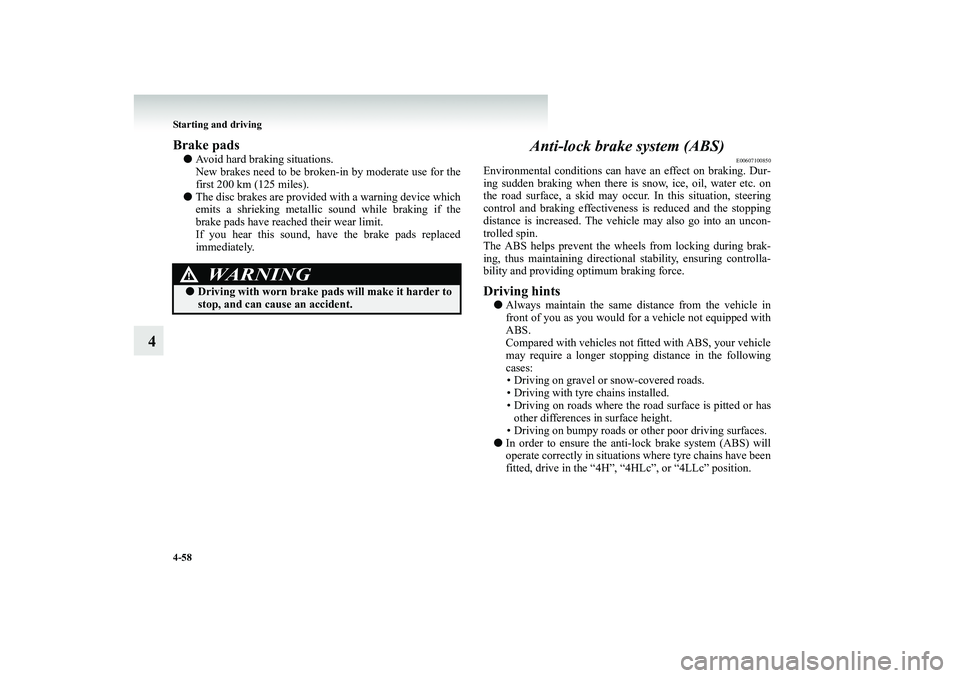
4-58 Starting and driving
4
Brake pads●
Avoid hard braking situations. New brakes need to be broken-in by moderate use for thefirst 200 km (125 miles).
●
The disc brakes are provided with a warning device which emits a shrieking metallic sound while braking if thebrake pads have reached their wear limit. If you hear this sound, have the brake pads replaced immediately.
Anti-lock brake system (ABS)
E00607100850
Environmental conditions can ha
ve an effect on braking. Dur-
ing sudden braking when there is
snow, ice, oil, water etc. on
the road surface, a skid may occu
r. In this situation, steering
control and braking effectivenes
s is reduced and the stopping
distance is increased. The vehicl
e may also go into an uncon-
trolled spin.The ABS helps prevent the wheel
s from locking during brak-
ing, thus maintaining directional stability, ensuring controlla- bility and providing optimum braking force.Driving hints●
Always maintain the same di
stance from the vehicle in
front of you as you would for a vehicle not equipped with ABS. Compared with vehicles not fitted with ABS, your vehiclemay require a longer stopping distance in the following cases: • Driving on gravel or snow-covered roads.• Driving with tyre chains installed. • Driving on roads where the
road surface is pitted or has
other differences in surface height.• Driving on bumpy roads or
other poor dr
iving surfaces.
●
In order to ensure the anti
-lock brake system (ABS) will
operate correctly in situations
where tyre chains have been
fitted, drive in the “4H”,
“4HLc”, or “4LLc” position.
WARNING
!●
Driving with worn brake pads will make it harder to stop, and can cause an accident.
BK-BK2008E1ENUK.en-uk-Section7.fm Page
58 Wednesday, January 9, 2008 4:36 PM